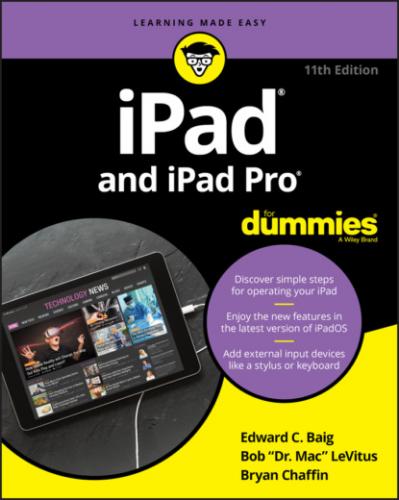Headphone jack: This jack lets you plug in a headset. You can use pretty much any headphone or headset that plugs into a 3.5-mm stereo headphone jack. Apple no longer makes headphones with a headphone jack, but it does sell EarPods ($29), which connect via a Lightning connector, and AirPods (starting at $159), which connect via Bluetooth.Throughout this book, we use the words headphones, earphones, and headset interchangeably. Strictly speaking, a headset includes a microphone so that you can talk (or record) as well as listen; headphones and earphones are for listening only. Either type works with your iPad, as do most wireless Bluetooth headsets such as Apple’s AirPods and newer headsets with Lightning connectors.
Microphone: The tiny dot — or two dots on some iPad Pro models — in the middle of the top is a pretty good microphone. (Hint: You’ll sound better if you use a headset — any headset.)
Speakers (iPad Pro only): iPad Pro has four speaker vents, two on the top and two on the bottom.
FIGURE 1-1: iPad Pro models have speaker ports on the top, as well as the sleep/wake button. Some models have a headphone jack, too.
On the bottom
On the bottom of your iPad are the speakers (two of the four speakers on iPad Pro models) and Lightning connector or USB-C connector, as shown in Figure 1-2:
Speakers: The speakers plays audio — music or video soundtracks — if you don't have a headset plugged in.
Lightning or USB-C connector: This connector has three purposes:Recharge your iPad’s battery: Simply connect one end of the included cable to the iPad’s Lightning or USB-C port and the other end to a USB or USB-C port, where appropriate.Synchronize your iPad: Connect one end of the same cable to the Lightning or USB-C connector and the other end to a USB or USB-C port on your Mac or PC.Connect your iPad to a camera or television: Make sure to use an adapter that works with the Lightning connector or the USB-C connector, depending on your iPad. If you connect your iPad to a USB port and get a Not Charging message, the USB port doesn't have enough power. Generally speaking, USB ports built into recent Macs and PCs, on powered hubs, or on the USB charging brick that came with your iPad will charge your iPad properly. Any USB data port connected to your Mac or PC will allow you to sync your iPad, whether or not it's charging.
FIGURE 1-2: All full-size iPad models have speaker ports and a connection port on the bottom.
On the right side of your iPad are the volume up and volume down buttons, as shown in Figure 1-3. Press the upper button to increase the volume; press the lower button to decreases the volume.
FIGURE 1-3: The right side of the iPad features volume buttons, and some feature a SIM tray, too.
On older iPads with cellular capabilities, you’ll find the SIM card tray. On newer iPads and iPad Pro with cellular capabilities, the SIM card tray is on the right side. Wi-Fi-only models do not have a SIM card tray.
On the front and back
On the front and back of your iPad, you find the following (labeled in Figure 1-4):
Touchscreen: You find out how to use the iPad’s gorgeous high-resolution color touchscreen in Chapter 2. All we have to say here is: Try not to drool all over it.
Home button, Touch ID sensor, or Face ID: No matter what you’re doing, you can press the Home button at any time to display the Home screen, as shown in Figure 1-4. The Home button also doubles as a Touch ID sensor on most iPads, so you can use your fingerprint (or a passcode) to unlock your phone and authenticate purchases. Recent iPad Pro models do not have a Home button and rely on Face ID, not Touch ID. For iPads with Face ID, swipe up from the bottom of the screen to go back to the Home screen.
Front (FaceTime) camera: The front camera is serviceable and delivers decent-enough video for video chats and such, but it’s not particularly good for taking still photos. That is, unless your iPad is a Pro model, which offers 7-megapixel front camera photos (versus 1.2 megapixels on all other models).
App icons: Each of the icons shown on the screen (see Figure 1-4) launches an included iPad app. You read more about these apps later in this chapter and throughout the rest of the book.
Rear camera: The camera on the back, just below the sleep/wake button, is better than the one in front. Pro models have a 12-megapixel rear camera with an f/1.8 aperture; other iPads have an 8-megapixel rear camera with f/2.4 apertures. All iPads can record HD video at 1080p; Pro models can record video at up to 4K.
FIGURE 1-4: The front of the iPad 10.2-inch: a study in elegant simplicity.
Status bar
The status bar, which is at the top of the screen, displays tiny icons that provide a variety of information about the current state of your iPad:
Airplane mode: Airplane mode should be enabled when you fly. It turns off all wireless features of your iPad — the cellular, 5G, 4G, LTE, 3G, GPRS, and EDGE networks; Wi-Fi; and Bluetooth — so you can enjoy music, video, games, photos, or any app that doesn’t require an Internet connection while you’re in the air.Tap the Settings app and then tap the airplane mode switch on (so green is displayed). The icon shown in the margin appears on the left side of your status bar when airplane mode is enabled. You can also pull Control Center down from the top-right corner and tap the airplane mode icon to turn airplane mode on (the
